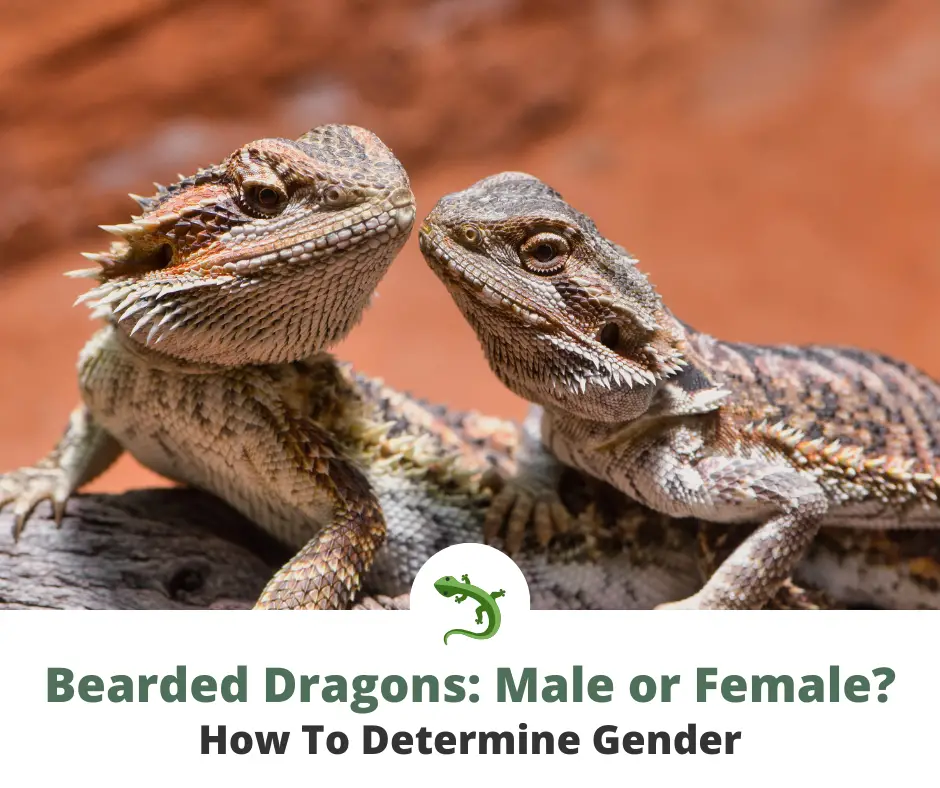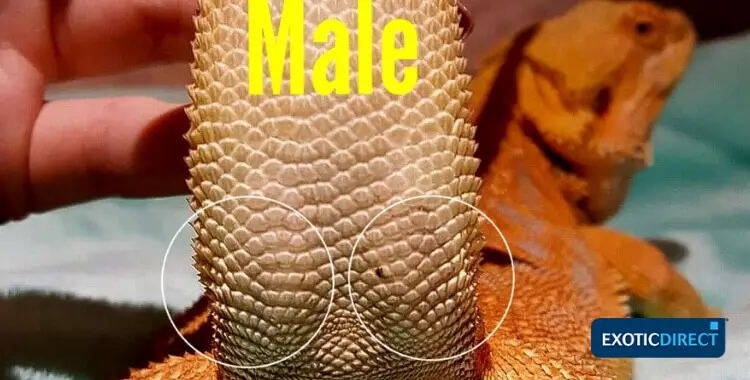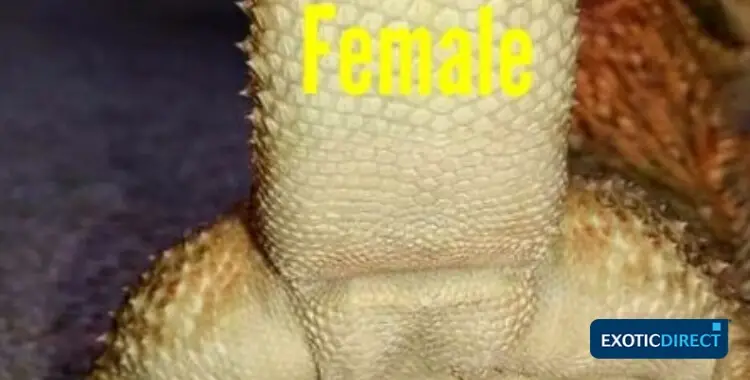Is your bearded dragon a male or female? Telling the gender of a bearded dragon is not exactly easy, but it is possible to do at home.
In this guide, you’ll learn:
- How to sex a bearded dragon
- Male vs female bearded dragon behavior
- Should you get a male or female bearded dragon?

At what age can you tell the sex of a bearded dragon?
It can be challenging to determine the sex of bearded dragons when they are babies, and it is typically best to wait until they are between 8 and 12 weeks of age. Experienced keepers may be able to tell earlier, but it can be difficult for new dragon owners, and if you want to be confident, waiting longer is the best option.
When determining the sex, you need to look for the reproductive organs fully developed at about one year of age. There are various methods to assess their sex that will be discussed in the next section, but for young bearded dragons, you can often tell a male from a female by looking at the tail. Usually, the female tails have a more narrow base, and the males have a broader base. This can be hard to determine unless you have multiple lizards of the same age to compare to each other.
How to sex a bearded dragon
Bearded dragons are sexually dimorphic, meaning males and females look different. These differences are present in their reproductive organs and body structure.
Their tail base varies in size, as does the width of their skull, and males have a broader bone structure. There are various other methods for determining the sex of your bearded dragon; they work best when the dragon is at least a year old.
Hemipenal Buldges
At about 4-8 months old, male bearded dragons develop hemipenal bulges. These two lateral reproductive organs are visible near the base of the tail, near the cloaca. You may need to lift your dragon’s tail to view these bulges. I recommend waiting until you and your dragon trust each other if it is a new pet to you because simple handling is required.


How to sex a bearded dragon:
- Pick up your bearded dragon and place them on a flat surface like a table or resting against your forearm. If they are held rather than on a flat surface, support all four feet so they feel safe.
- Lift the tail. Do not lift your dragon’s tail by the tip, as it can injure them. Lift it gently without exceeding about 60 degrees. Any further, and you could hurt your bearded dragon’s back. You want to look at the base and see if two bulges are present.
- If you see two dark patches on either side, it is likely male. If there is only one dark patch and it is central, this is likely a female. If the bulges are challenging to see, you may have a female.
Pro-Tip ⚡
Use a flashlight! Gently place a small flashlight on the dragon’s back at the very base of the tail when lifting. Make sure your flashlight is small because if it is too heavy, you could injure your dragon. This method works well for young bearded dragons.
Femoral Pores
Bearded dragons use femoral pores to release pheromones that help them find and attract partners during mating season. Along their back legs, these pores are on the underside of the dragon. They are typically linear, and with the natural position a dragon sits in, they form a triangle pointing towards the cloaca. Males and females differ in that males have much larger femoral pores.
It can be challenging to determine larger pores from smaller pores, but if you have multiple different dragons to compare to each other, it is relatively easy. This method works best when the dragon is fully sexually mature, usually at least one year of age.
Behavior
Male and female bearded dragons tend to act differently from one another. The males are known for having a black beard that they puff up with spikes when ready to mate. They also have more of an attitude in that they can stomp and hiss. Females usually wave their arms when looking to breed, use their spikes when defending themselves, and spend more time digging. The females dig more because if they were to have a clutch of eggs when they are ready to lay, the dragons bury them in sand holes to hide them from predators and to regulate the incubation temperatures.
It can take a lot of experience owning and learning the behavior of bearded dragons before these signs are visibly male or female. Both sexes behave this way as it is crucial to their survival to dig to find food and control temperatures. They also both use their spikes for defense, if necessary.
Males vs. Females: What are the differences?
Male and female dragons vary from one another physically and behaviorally. Sometimes males can require more experience as they often exhibit territorial behavior. I personally prefer the company of female bearded dragons as I have never encountered an aggressive one. They are typically relaxed and allow for a relaxing experience when you spend time with them.
Size
Male bearded dragons are generally bigger. The target weight for an adult is around 550 grams, whereas, for females, it is only 450-500 grams. The male’s skulls are more prominent and broader, and their tails have more girth at the base, not necessarily longer.
Behavior
There are two forms of body language that bearded dragons use most, head bobbing and arm waving.
Male bearded dragons can be highly territorial and exhibit certain behaviors to get other dragons to leave them alone and evacuate their space. They will puff out their beard and turn it dark black. This color change happens when they change the direction of the scales. They also open their mouth, hiss, and turn their body into defensive positioning. If you have two bearded dragons in an enclosure together, it often ends fatally due to their territorial reactions.

Females are less territorial. They may puff out their beard and engage their spikes, but they typically do it out of a defense mechanism if you or a predator approaches them. They also prefer the action of hand waving rather than head bobbing. Head bobbing is more of a dominance behavior, and hand waving is submissive.
Sexual Dimorphism
The two most visible organs are the hemipenal bulges and the femoral pores. The hemipenal bulges are present in the males and are located near the cloaca laterally, and the females have a singular prominent bulge above the cloaca. Hemipenal bulges are the external visibility of hemipenes. Hemipenes are the reptilian form of a penis, and it is believed they have two for better positioning when competing for mating and following through with the mating process. Also, if one gets damaged, they have a ‘backup.’
The femoral pores are located on the underside of the legs, near the thighs, and toward the feet. They are linear and look like holes or, occasionally, pimples if they are clogged up. These pores are essential for pheromones as the dragons rub their legs on rocks and branches, and the waxy substance of their pheromones rubs off on them. The male and female dragons can ‘smell’ this and use it to track each other. Males can find females to mate with, and vice versa, or males can find other males to fight with to defend their territory.
Should you get a male or female bearded dragon?
I have owned many bearded dragons throughout my life and preferred the company of females. I have raised females and males from babies but never experienced aggressive behavior from females.
In my experience, males undergo a particularly testy phase as they go through ‘puberty’ and fully develop their sex organs. Once they are developed, their territorial behavior kicks in, and they can be pretty feisty. Giving them space during this time by only handling them occasionally is the best until they are fully developed and their hormones are more regulated. From that point, they are just as sweet as females.
Male bearded dragon pros and cons
| Pros | Cons |
|---|---|
| They are very active in their enclosure and, therefore, more attractive to view | They can be restless and aggressive when feeling territorial |
| They get larger if a bigger lizard is desirable to you | They can go through a feisty phase as they are developing |
| They are easier to sex at a younger age | It may take more time for them to be handleable |
Female bearded dragon pros and cons
| Pros | Cons |
|---|---|
| They are usually very friendly and not territorial | The sound of their digging can be disruptive if they are housed in your bedroom |
| Their waving motions can make you feel like they are connecting with you | They can have more health issues if not cared for properly, with egg laying, such as being egg-bound |
| They are a bit smaller and can be more manageable for first-time pet owners | It can be more challenging to sex them at a young age |
FAQs
Can you tell a bearded dragon’s gender as a baby?
Yes, you can tell a bearded dragon’s gender as a baby, but it can be tricky. If you would like to be more certain about the sex of your dragon, it is best to wait until they are 8 to 12 weeks old. They are fully sexually mature at one year old when you can be confident in the identification.
If you would like to try to sex your baby bearded dragon, look for internal sex organs by lifting the tail (not by the tip) and by using a flashlight on the ‘top’ of the lizard to locate the number of organs. They are visible from underneath the tail. Two dark spots means male and one means female.
Can male bearded dragons turn into females?
Yes, bearded dragons can turn into females, but only during the incubation period of their egg.
When an egg is incubated, it can be laid with the genetic makeup of a male, but when incubated at high temperatures, it can convert to a female. Scientists are still determining how this function works, but bearded dragons do not follow the same homo and heterogametic system as we mammals do. However, once your bearded dragon is hatched, it cannot change into a female.


